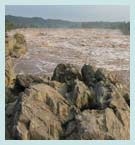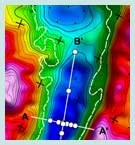| |
 |
 |
 |
|
 |
 |
 |
 |
 |

|
 |
 |
|
|
|
 |
NSF Names 34 International Research Fellows
Awards honor promising early career U.S. scientists and engineers
|
 |
| |
 What do solar cells based on dye-sensitized nanoparticles, disaster preparedness and response in Central Mexico, and the long-wattled umbrellabird all have in common? All are among the diverse research topics 34 new recipients of the National Science Foundation’s (NSF) International Research Fellowships for 2004 have chosen to study. Awarded to promising and talented American postdoctoral scientists and engineers, the fellowships enable budding researchers to conduct leading-edge research for up to two years in biology, physics, engineering, geosciences, computer science, and social and behavioral sciences. The work is done with international collaboration, use of overseas instrumentation or through unique research environments available abroad. What do solar cells based on dye-sensitized nanoparticles, disaster preparedness and response in Central Mexico, and the long-wattled umbrellabird all have in common? All are among the diverse research topics 34 new recipients of the National Science Foundation’s (NSF) International Research Fellowships for 2004 have chosen to study. Awarded to promising and talented American postdoctoral scientists and engineers, the fellowships enable budding researchers to conduct leading-edge research for up to two years in biology, physics, engineering, geosciences, computer science, and social and behavioral sciences. The work is done with international collaboration, use of overseas instrumentation or through unique research environments available abroad.
Credit: Alex Agrios, Northwestern University
Read the full story. ... Posted
7/27/04
|
 |
NSF Awards $10 Million in Grants to Ocean Sites for Long-Term Ecological Research
|
 |
| |
 Coral reefs and coastal upwelling ecosystems are the subjects of two new Long-Term Ecological Research (LTER) sites awarded funding by the National Science Foundation. With the addition of the Moorea Coral Reef LTER Site and the California Current Ecosystem LTER Site, there are now 26 NSF-funded sites in the LTER network. The two newest sites will receive approximately $820,000 for the next six years, for a total of about $ 5 million each. "These two new sites significantly augment the LTER network, which had included only one marine site, in the Antarctic," says Henry Gholz, director of NSF's LTER program. "The awards ensure that high biodiversity and productivity ecosystems in most of the world's major biomes, both on land and in the oceans, are represented." Coral reefs and coastal upwelling ecosystems are the subjects of two new Long-Term Ecological Research (LTER) sites awarded funding by the National Science Foundation. With the addition of the Moorea Coral Reef LTER Site and the California Current Ecosystem LTER Site, there are now 26 NSF-funded sites in the LTER network. The two newest sites will receive approximately $820,000 for the next six years, for a total of about $ 5 million each. "These two new sites significantly augment the LTER network, which had included only one marine site, in the Antarctic," says Henry Gholz, director of NSF's LTER program. "The awards ensure that high biodiversity and productivity ecosystems in most of the world's major biomes, both on land and in the oceans, are represented."
Image: (c) MacGillivray Freeman Films
Read the full story. ... Posted
7/27/04
|
 |
Geologists Discover Water Cuts Through Rock at Surprising Speed
|
 |
| |
 In the first study to directly measure when and how quickly rivers outside of growing mountain ranges cut through rock, geologists at the University of Vermont have determined that it was about 35,000 years ago that the Potomac and Susquehanna rivers, respectively, began carving out the Great Falls of the Potomac and Holtwood Gorge. Great Falls, located about 15 miles outside of Washington, D.C., hosts hundreds of thousands of visitors each year; Holtwood Gorge lies along the Susquehanna River, near Harrisburg, Penn. As reported in the July 23 issue of the journal Science, the geologists analyzed rock samples collected from the gorges for 10-beryllium, a very rare isotope that is produced when cosmic rays collide with rocks and sediments at the Earth's surface. These analyses helped them gauge when the rivers abandoned their ancient beds and, consequently, exposed bare rock surfaces, known as terraces, where people climb and hike today. In the first study to directly measure when and how quickly rivers outside of growing mountain ranges cut through rock, geologists at the University of Vermont have determined that it was about 35,000 years ago that the Potomac and Susquehanna rivers, respectively, began carving out the Great Falls of the Potomac and Holtwood Gorge. Great Falls, located about 15 miles outside of Washington, D.C., hosts hundreds of thousands of visitors each year; Holtwood Gorge lies along the Susquehanna River, near Harrisburg, Penn. As reported in the July 23 issue of the journal Science, the geologists analyzed rock samples collected from the gorges for 10-beryllium, a very rare isotope that is produced when cosmic rays collide with rocks and sediments at the Earth's surface. These analyses helped them gauge when the rivers abandoned their ancient beds and, consequently, exposed bare rock surfaces, known as terraces, where people climb and hike today.
Credit: Paul Bierman / University of Vermont
Read the full story. ... Posted
7/23/04
|
 |
New Martian Meteorite Found in Antarctica
|
 |
| |
 While rovers and orbiting spacecraft scour Mars searching for clues to its past, researchers have uncovered another piece of the Red Planet in Antarctica.
The new specimen was found by a field party from the U.S. Antarctic Search for Meteorites program (ANSMET) on Dec. 15, 2003, on an icefield in the Miller Range of the Transantarctic Mountains, roughly 750 kilometers (466 miles) from the South Pole. This 715.2 gram (1.5 pound) black rock, officially designated MIL 03346, was one of 1358 meteorites collected by ANSMET during the 2003-2004 austral summer. Scientists at the Smithsonian Institution's National Museum of Natural History involved in classification of Antarctic finds said the mineralogy and texture of the meteorite are unmistakably Martian. The new specimen is the seventh recognized member of a group of Martian meteorites called the nakhlites, named after the first known specimen that fell in Nakhla, Egypt in 1911. While rovers and orbiting spacecraft scour Mars searching for clues to its past, researchers have uncovered another piece of the Red Planet in Antarctica.
The new specimen was found by a field party from the U.S. Antarctic Search for Meteorites program (ANSMET) on Dec. 15, 2003, on an icefield in the Miller Range of the Transantarctic Mountains, roughly 750 kilometers (466 miles) from the South Pole. This 715.2 gram (1.5 pound) black rock, officially designated MIL 03346, was one of 1358 meteorites collected by ANSMET during the 2003-2004 austral summer. Scientists at the Smithsonian Institution's National Museum of Natural History involved in classification of Antarctic finds said the mineralogy and texture of the meteorite are unmistakably Martian. The new specimen is the seventh recognized member of a group of Martian meteorites called the nakhlites, named after the first known specimen that fell in Nakhla, Egypt in 1911.
Credit: ANSMET / Case Western University
Read the full story. ... Posted
7/20/04
|
 |
OSTP Director Unveils "Science for the 21st Century" Report
|
 |
| |
 The National Science and Technology Council, a Cabinet-level Council that coordinates science and technology policies across the Federal Government, today released a report "Science for the 21st Century." Produced under the direction of the NSTC's Committee on Science, the report provides a Federal agency perspective on the science policies and accomplishments of the Bush Administration and illustrates how today's science sets the stage for benefits to the economy and national quality of life far into the future. "The Federal government plays a key role in supporting the country's science infrastructure, a national treasure, and scientific research, an investment in our future," said John H. Marburger III, science advisor to the President and director, Office of Science and Technology Policy. "This report presents the critical responsibilities of our Federal science enterprise and the actions taken by the Federal research agencies to align our programs with scientific opportunity and national needs," Marburger said. The National Science and Technology Council, a Cabinet-level Council that coordinates science and technology policies across the Federal Government, today released a report "Science for the 21st Century." Produced under the direction of the NSTC's Committee on Science, the report provides a Federal agency perspective on the science policies and accomplishments of the Bush Administration and illustrates how today's science sets the stage for benefits to the economy and national quality of life far into the future. "The Federal government plays a key role in supporting the country's science infrastructure, a national treasure, and scientific research, an investment in our future," said John H. Marburger III, science advisor to the President and director, Office of Science and Technology Policy. "This report presents the critical responsibilities of our Federal science enterprise and the actions taken by the Federal research agencies to align our programs with scientific opportunity and national needs," Marburger said.
Read the report.
Read about NSF examples mentioned. ... Posted
7/20/04
|
 |
Impact of Earth's Rising Atmospheric Carbon Dioxide Found in World Oceans
|
 |
| |
 An international team of scientists has completed the first comprehensive study of the ocean storage of carbon dioxide derived from human activity, called anthropogenic CO2, based on a decade-long survey of global ocean carbon distributions in the 1990s. The findings, along with those detailed in a companion paper on the impacts of anthropogenic CO2 on the chemistry of the oceans and the potential response of marine animals and plants to changes in CO2 levels, were published in the July 16 issue of the journal Science. "About half of the anthropogenic CO2 taken up over the last 200 years can be found in the upper 10 percent of the ocean," said Christopher Sabine, an oceanographer at NOAA's Pacific Marine Environmental Laboratory (PMEL) in Seattle, Wash. Sabine is the lead author of one of the papers. "The ocean has removed 48 percent of the CO2 we have released to the atmosphere from burning fossil fuels and cement manufacturing." An international team of scientists has completed the first comprehensive study of the ocean storage of carbon dioxide derived from human activity, called anthropogenic CO2, based on a decade-long survey of global ocean carbon distributions in the 1990s. The findings, along with those detailed in a companion paper on the impacts of anthropogenic CO2 on the chemistry of the oceans and the potential response of marine animals and plants to changes in CO2 levels, were published in the July 16 issue of the journal Science. "About half of the anthropogenic CO2 taken up over the last 200 years can be found in the upper 10 percent of the ocean," said Christopher Sabine, an oceanographer at NOAA's Pacific Marine Environmental Laboratory (PMEL) in Seattle, Wash. Sabine is the lead author of one of the papers. "The ocean has removed 48 percent of the CO2 we have released to the atmosphere from burning fossil fuels and cement manufacturing."
Photo credit: iStockPro
Read the full story. ... Posted
7/15/04
|
 |
New Map Reveals Hidden Features of Ice-buried Antarctic Lake
Measurement shows that two distinct ecosystems may exist
|
 |
| |
 Scientists from the Lamont-Doherty Earth Observatory (LDEO) at Columbia University and Rensselaer Polytechnic Institute in New York State have developed the first-ever map of water depth in Lake Vostok, which lies between 3,700 and 4,300 meters (more than 2 miles) below the continental Antarctic ice sheet. The new comprehensive measurements of the lake—roughly the size of North America's Lake Ontario—indicate it is divided into two distinct basins that may have different water chemistry and other characteristics. The findings have important implications for the diversity of microbial life in Lake Vostok and provide a strategy for how scientists study the lake’s different ecosystems should international scientific consensus approve exploration of the pristine and ancient environment. Scientists from the Lamont-Doherty Earth Observatory (LDEO) at Columbia University and Rensselaer Polytechnic Institute in New York State have developed the first-ever map of water depth in Lake Vostok, which lies between 3,700 and 4,300 meters (more than 2 miles) below the continental Antarctic ice sheet. The new comprehensive measurements of the lake—roughly the size of North America's Lake Ontario—indicate it is divided into two distinct basins that may have different water chemistry and other characteristics. The findings have important implications for the diversity of microbial life in Lake Vostok and provide a strategy for how scientists study the lake’s different ecosystems should international scientific consensus approve exploration of the pristine and ancient environment.
Credit: Michael Studinger / National Science Foundation
Read the full story. ... Posted
7/8/04
|
 |
A New Twist on Fiber Optics
Spiraling glass fibers provide new way to control behavior of light
|
 |
| |
 By twisting fiber optic strands into helical shapes, researchers have created unique structures that can precisely filter, polarize or scatter light. Compatible with standard fiber optic lines, these hair-like structures may replace bulky components in sensors, gyroscopes and other devices. While researchers are still probing the unusual properties of the new fibers, tests show the strands impart a chiral, or "handed," character to light by polarizing photons according to certain physical properties. Victor Kopp of Chiral Photonics in Clifton, N.J., and his colleagues describe the new fibers in the July 2 issue of Science. By twisting fiber optic strands into helical shapes, researchers have created unique structures that can precisely filter, polarize or scatter light. Compatible with standard fiber optic lines, these hair-like structures may replace bulky components in sensors, gyroscopes and other devices. While researchers are still probing the unusual properties of the new fibers, tests show the strands impart a chiral, or "handed," character to light by polarizing photons according to certain physical properties. Victor Kopp of Chiral Photonics in Clifton, N.J., and his colleagues describe the new fibers in the July 2 issue of Science.
Credit: Chiral Photonics, Inc. / National Science Foundation
Read the full story. ... Posted
7/1/04
|
 |
Searing Heat, Little Package
High-temperature lab-on-a-chip can get hotter than surface of Venus
|
 |
| |
 Engineers have created a miniature hotplate that can reach temperatures above 1100°C (2012°F), self-contained within a "laboratory" no bigger than a child's shoe. The micro-hotplates are only a few dozen microns across (roughly the width of a human hair), yet are capable of serving as substrates, heaters and conductors for thin-film experiments ranging from material analyses to the development of advanced sensors. Researchers at Boston MicroSystems, Inc., craft the hotplates out of silicon carbide, a robust material that can tolerate extreme heat and reach peak temperature in less than one-thousandth of a second. Engineers have created a miniature hotplate that can reach temperatures above 1100°C (2012°F), self-contained within a "laboratory" no bigger than a child's shoe. The micro-hotplates are only a few dozen microns across (roughly the width of a human hair), yet are capable of serving as substrates, heaters and conductors for thin-film experiments ranging from material analyses to the development of advanced sensors. Researchers at Boston MicroSystems, Inc., craft the hotplates out of silicon carbide, a robust material that can tolerate extreme heat and reach peak temperature in less than one-thousandth of a second.
Credit: Boston Microsystems, Inc. / National Science Foundation
Read the full story. ... Posted
7/1/04
|
 Top of Page Top of Page
|
|
|
 |
 |
 |
 |
 |
 |
 |
 |
|
 |
 |
 |
|
|

